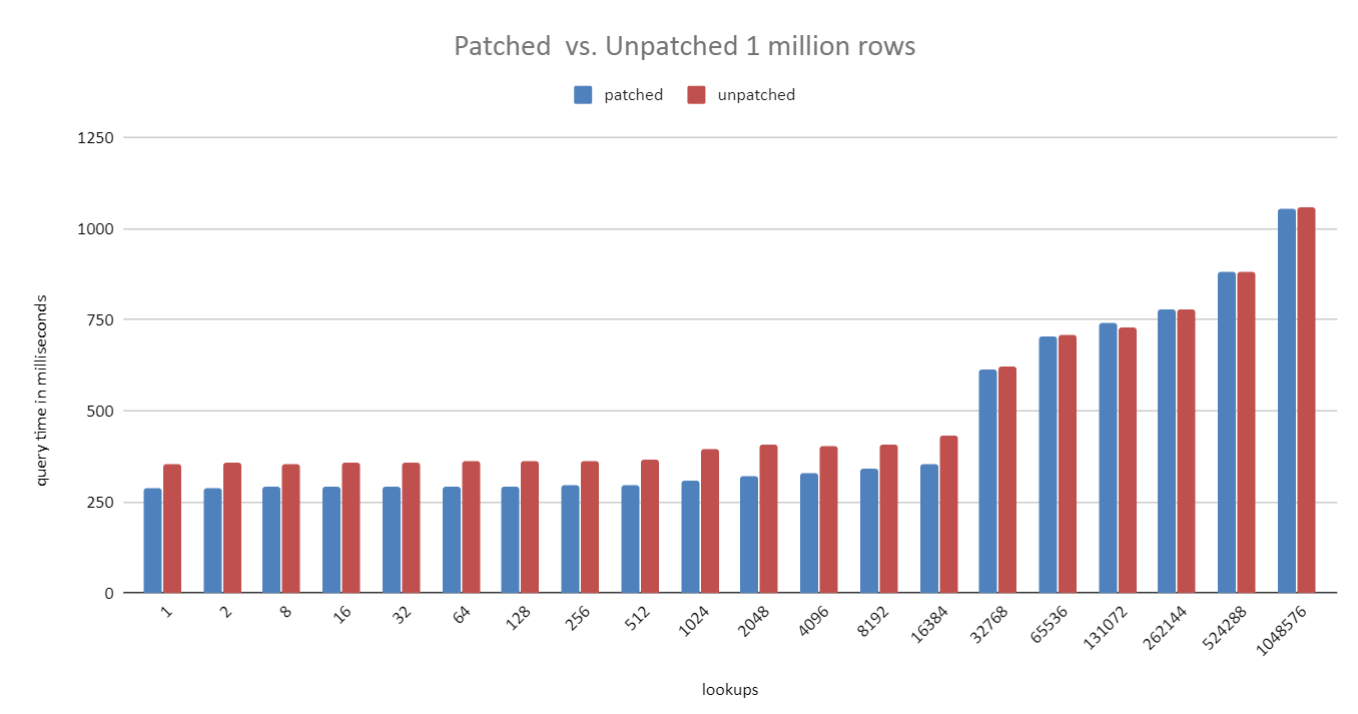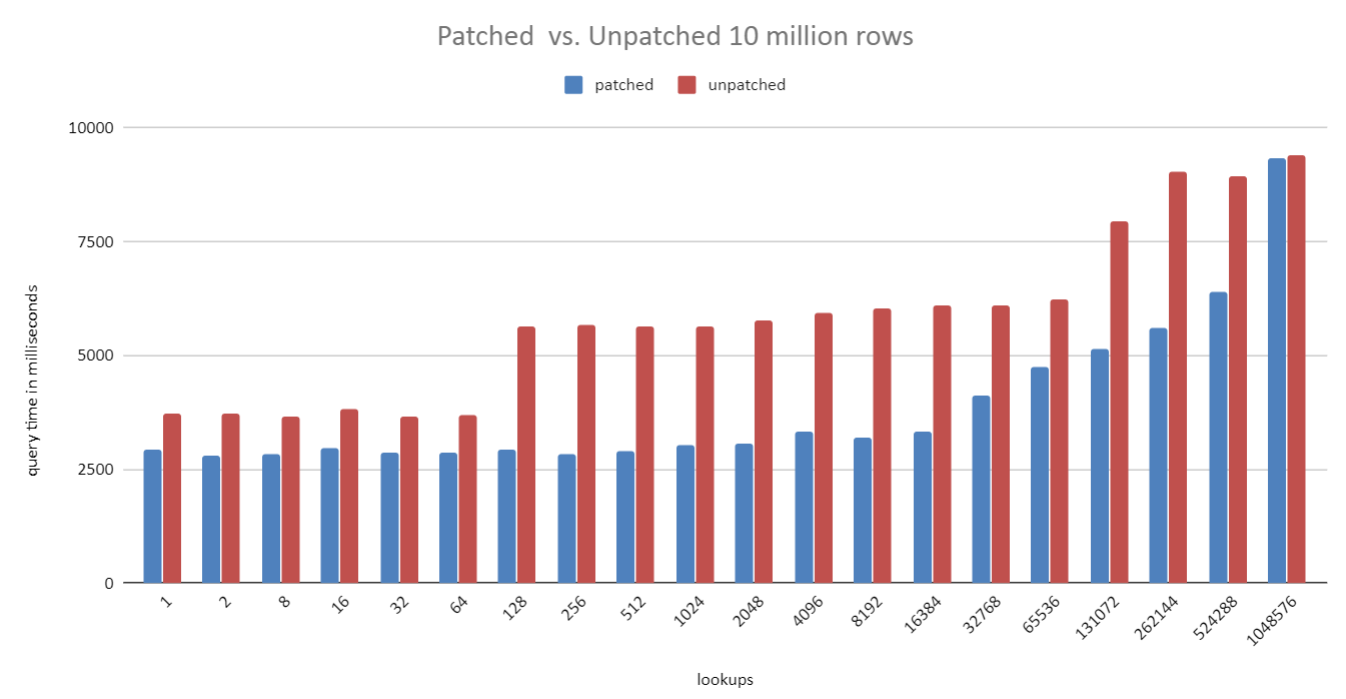Re: Hybrid Hash/Nested Loop joins and caching results from subplans
| From: | David Rowley <dgrowleyml(at)gmail(dot)com> |
|---|---|
| To: | Andy Fan <zhihui(dot)fan1213(at)gmail(dot)com> |
| Cc: | Simon Riggs <simon(at)2ndquadrant(dot)com>, PostgreSQL Developers <pgsql-hackers(at)lists(dot)postgresql(dot)org> |
| Subject: | Re: Hybrid Hash/Nested Loop joins and caching results from subplans |
| Date: | 2020-07-07 12:32:22 |
| Message-ID: | CAApHDvoGUsdPORSND25Zumk9e81b=Em22LdyiunB1Cgi8L0_bA@mail.gmail.com |
| Views: | Raw Message | Whole Thread | Download mbox | Resend email |
| Thread: | |
| Lists: | pgsql-hackers |
On Thu, 2 Jul 2020 at 22:57, David Rowley <dgrowleyml(at)gmail(dot)com> wrote:
> I've attached the v2 patch series.
There was a bug in v2 that caused the caching not to work properly
when a unique join skipped to the next outer row after finding the
first match. The cache was not correctly marked as complete in that
case. Normally we only mark the cache entry complete when we read the
scan to completion. Unique joins is a special case where we can mark
it as complete early.
I've also made a few more changes to reduce the size of the
ResultCacheEntry struct, taking it from 40 bytes down to 24. That
matters quite a bit when the cached tuple is very narrow. One of the
tests in resultcache.out, because we can now fit more entries in the
cache, it reports a 15% increase in cache hits.
I also improved the costing regarding the estimate of how many cache
entries we could fit in work mem. Previously I was not accounting for
the size of the cache data structures in memory. v2 only accounted for
the tuples themselves. It's important to count these as if we don't
then it could cause the costing to think we could fit more entries
than we actually could which meant the estimated number of cache
evictions was off and could result in preferring a result cache plan
when we perhaps shouldn't.
I've attached v4.
I've also attached a bunch of benchmark results which were based on v3
of the patch. I didn't send out v3, but the results of v4 should be
almost the same for this test. The script to run the benchmark is
contained in the resultcachebench.txt file. The benchmark just mocks
up a "parts" table and a "sales" table. The parts table has 1 million
rows in the 1 million test, as does the sales table. This goes up to
10 million and 100 million in the other two tests. What varies with
each bar in the chart is the number of distinct parts in the sales
table. I just started with 1 part then doubled that up to ~1 million.
The unpatched version always uses a Hash Join, which is wasteful since
only a subset of parts are looked up. In the 1 million test the
planner switches to using a Hash Join in the patched version at 65k
parts. It waits until the 1 million distinct parts test to switch
over in the 10 million and 100 million test. The hash join costs are
higher in that case due to multi-batching, which is why the crossover
point is higher on the larger scale tests. I used 256MB work_mem for
all tests. Looking closely at the 10 million test, you can see that
the hash join starts taking longer from 128 parts onward. The hash
table is the same each time here, so I can only suspect that the
slowdown between 64 and 128 parts is due to CPU cache thrashing when
getting the correct buckets from the overly large hash table. This is
not really visible in the patched version as the resultcache hash
table is much smaller.
David
| Attachment | Content-Type | Size |
|---|---|---|
| resultcachebench.txt | text/plain | 1.8 KB |
| v4-0002-Allow-users-of-simplehash.h-to-perform-direct-del.patch | application/octet-stream | 4.7 KB |
| v4-0001-Allow-estimate_num_groups-to-pass-back-further-de.patch | application/octet-stream | 8.8 KB |
| v4-0003-Add-Result-Cache-executor-node.patch | application/octet-stream | 155.9 KB |

|
image/png | 58.6 KB |

|
image/png | 61.3 KB |

|
image/png | 62.3 KB |
In response to
- Re: Hybrid Hash/Nested Loop joins and caching results from subplans at 2020-07-02 10:57:44 from David Rowley
Responses
- Re: Hybrid Hash/Nested Loop joins and caching results from subplans at 2020-07-08 03:37:09 from David Rowley
Browse pgsql-hackers by date
| From | Date | Subject | |
|---|---|---|---|
| Next Message | David Rowley | 2020-07-07 12:54:44 | Re: Default setting for enable_hashagg_disk (hash_mem) |
| Previous Message | mailajaypatel | 2020-07-07 11:41:15 | Re: Question: PostgreSQL on Amazon linux EC2 |